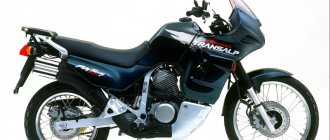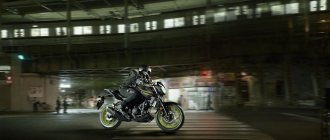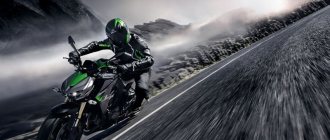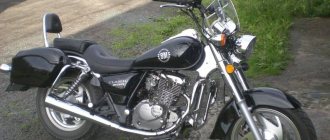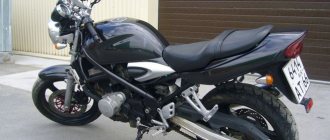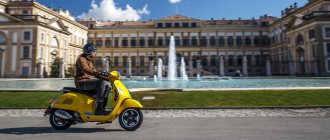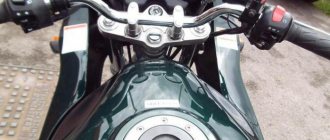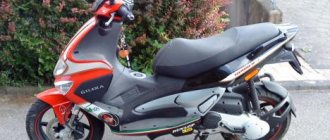Motocross, as already mentioned in the previous article, became the progenitor not only for a series of its own varieties (for example, motocross on a motorcycle with a sidecar), but also for several areas that subsequently received the official status of full-fledged independent disciplines. One of the youngest among them is supermoto.
This trend is interesting not only for its youth, but also for a number of other reasons, including the format of the races and the events that led to their appearance. And for this alone it is worth paying special attention to this discipline.
basic information
Supermoto, at its core, is a mixture of motocross and road racing. The routes for it are always winding, closed in a ring and have a combined surface consisting of asphalt (about 70%) and dirt (30%) sections. On the latter, various natural or artificial obstacles are necessarily organized. The total length of the route is from 1 to 2 km. A standard race includes a series of heats, each lasting 20 minutes + 1 lap. Participants start at the same time.
History of appearance
The history of supermoto is extremely unusual. While other disciplines were the result of the logical development of pre-existing competitions or attempts to adjust them to existing restrictions (as was the case, for example, with speedway), the prerequisite for the emergence of this direction was a simple entertaining TV show Superbikers, organized in the USA in 1979. Within its framework, superstars from almost all then existing disciplines came together in various disciplines (motocross, circuit racing, drag racing, trials). They had one goal - to prove that their motorcycle, chosen before the very first race, was the most versatile and fastest in constantly changing conditions.
By 1985, the show, despite its initial huge success, was closed due to personnel changes at the channel and falling ratings. And if it weren’t for the French racers who returned home after participating in it, this kind of competition could well have sunk into oblivion. But the French interest in unusual racing did not fade away, but flared up with renewed vigor in a local series of races called Supermotard (motard in French means motorcyclist).
A slight digression should be made here, since all this has caused some confusion with the Russian names of the discipline and motorcycles, which appeared due to the difference between the English and French names of the original competitions. Among professionals, the word “supermoto” is used to refer exclusively to motorsports, and motorcycle models for it are called motards or, less commonly, supermotards.
This is how the supermoto, which requires dual training from the rider (endurance to control a motorcycle off-road and refinement of movements to develop maximum speed on asphalt), began its victorious march across France.
The discipline turned out to be extremely entertaining, as it offered the viewer exactly what he loves most: speed and a serious challenge to the participants. All this was beneficial not only to the organizers, but also to television, which again turned its attention to supermoto in 1993. It also contributed to its further development, since broadcasts of local competitions were carried out not only in their home country, but also in neighboring Italy and Spain. Soon people started talking about a new type of racing all over Europe.
Just as TV eventually returned to supermoto, the discipline of motorcycling eventually regained popularity in the United States, where it even formed its own “school.” It differed from the “French” one familiar to Europeans in the ratio of paved and unpaved areas. It was dominated by unpaved sections, whereas in the “original” the main emphasis was placed on high-speed turns on asphalt.
Motorcycle Maico Supermoto 250 2003 review
Description of the Maico Supermoto 250 2003 motorcycle is in the queue for publication of the article. Announcement: Today, for almost every new motorcycle that comes into being, marketers strive to carve out their own niche. This one is a road sport, this one is a recreational enduro. But what class should we include a motorcycle that has a little bit of everything? A good bike should have a reliable engine, comfortable ergonomics and simple controls...
Maico Supermoto 250 is a motorcycle rarely sold in Russia, equipped with a high-power 54 hp engine. Despite the fact that good models of motorcycles have a very respectable price, and the season for their use is relatively short, the motorcycle market is developing rapidly. And if you believe the words of dealers, then some models of recently released motorcycles are selling like hot cakes at the beginning of the season, and the models brought to Russia are clearly not enough to fully satisfy consumer demand.
A motorcycle has long ceased to be an alternative to a car, and the times when this equipment was bought only because there was not enough money for a full-fledged car are forgotten. Nowadays, two-wheelers can be called technological marvels in many cases, and their cost can be compared with that of prestigious cars.
Many people have started buying motorcycles for hobby purposes as riding or even collecting them has become a good pastime for many people. Many motorcycles, for example the Maico Supermoto 250, whose technical characteristics make it possible to call the model a prestigious brand, are in demand among both beginners and experienced motorcyclists.
Currently, it is impossible to purchase a new Maico Supermoto 250 motorcycle from the 2003 model year, since their production stopped 13 years ago. At the same time, the Maico Supermoto 250 has excellent technical characteristics, so many people strive to purchase, if not a new, then at least a used version.
Motorcycles with an engine capacity of 247 cc / 15.1 cu in. see, appeared as a result of long work of inventors who sought to create a model that was not inferior in characteristics to other versions of the motorcycle. In some cases, these models are not only not inferior, but also ahead of other motorcycles, as they have minimal fuel consumption and other excellent parameters.
Maico Supermoto 250 belongs to a common class of motorcycles with an engine capacity of 125 to 250 kb. cmAs a rule, these are light and relatively low-power motorcycles. Here you will get flexible control, easy steering and low weight of the motorcycle. Therefore, such motorcycles are suitable for almost every beginner, regardless of their characteristics. The exception is motorcycles with two-stroke engines of the “sport” and “cross” classes, since bikes of this class are distinguished by more power and an extremely sharp response to the throttle, which also does not make them obedient to control.
Go to the entire range of Maico motorcycles, on this page you can find Maico Supermoto 250 motorcycles from other years of production and information about them
Main competitions
There were 2 most important events, in addition to the already mentioned TV show, for the establishment of supermoto as an official sport:
- Guidon d'Or (translated from French as “golden steering wheel”) is a series of grandiose races that annually brought together French and foreign riders on combined tracks in the early 90s and became one of the most significant impetuses for the further transformation of the entertainment program into a strictly regulated motorcycle sport .
- The first official supermoto championship organized by the American Motorcycle Association (AMA) in 2003.
Currently, the most important event for the discipline is the Supermoto World Championship (aka Supermoto S1GP), held under the auspices of the FIM in 2002-2003 and annually since 2010. It also regularly hosts the European Championship and an event similar to the “Motocross of Nations” - Supermoto of Nations.
The most significant for domestic athletes is the Russian Supermoto Championship.
Motorcycles for supermoto
And the last important aspect of the discipline is the features of the motorcycles used. Since initially athletes went to the track solely for the sake of entertainment, there were no special requirements for equipment and, in fact, the only restrictions in force were the distinction by engine size. Models with 2-stroke 500 or 4-stroke 750 cc engines took part in the races. However, already the first races put everything in its place.
Light motocross and enduro bikes have become ideal motorcycles, capable of overcoming all obstacles with almost equal success. Almost their only drawback was their tread pattern, which did not provide good grip when maneuvering and did not allow them to reach maximum speed on asphalt. Therefore, the first change that the participants personally made to the design was the replacement of tires.
Subsequently, the motorcycles were modernized many times, and some riders even worked on increasing engine power. The preparation of equipment remained in this semi-amateur state for quite a long time. Even the release of the first production motard Gilera Nordwest in 1991 did not affect the situation - it was specialized for easy maneuvering on flat areas, but too heavy for off-road use.
Large manufacturers, at the forefront of which were Husqvarna, KTM and CCM, entered the game fully only in the mid-90s. At the same time, the Japanese leaders in the motorcycle industry did not even try to participate in the “arms race” - they simply considered the new trend frivolous.
All this led to the emergence of a very interesting situation: since European serial motards were still based on classic motocross and enduro bikes, several enterprising companies began to purchase the most popular and successful Japanese motorcycles and modernize them themselves. Subsequently, they received a new design and entered the market under European brands, for example Dall'ara. In general, the situation with the technical equipment and general design of supermoto motorcycles remains the same to this day.
Road motorcycles
Classic
The most common and popular type of motorcycle. Purpose: travel on public roads in populated areas and on intercity routes. All types of motorcycles
classical type have common characteristics:
- vertical planting height 0.7–0.9 m;
- availability of lighting and signaling devices to ensure safety;
- minimum volume of facing elements;
- standard curved steering wheel.
The engine and gearbox of classic models have an increased service life. This is necessary, because the equipment will be used daily.
Sports
This type of motorcycle
always an example of the latest technological solutions. Main features: powerful boosted power unit, light weight. The driver's seating position is tilted forward to reduce wind resistance and increase controllability.
The design, components and assemblies are lightweight to increase maximum speed, control accuracy and achieve record acceleration. A forced engine makes it possible to achieve excellent dynamic performance.
Sports bikes need perfect track surfaces. They require proper and expensive maintenance. Due to their high power and sensitivity in control, only professionals can handle them.
Superbike
Superbikes are simplified analogues of unique sports prototypes. They have been put into serial factory production. Freely sold, available for driving on public roads. They retain the dynamic performance of professional racing equipment and install lighting devices to comply with traffic rules.
Saved:
- cowl;
- high running boards;
- steering device;
- forced power unit.
Superbikes are equipped with an improved braking system, reducing only the maximum angle of inclination for cornering, so that not only professional racers, but also experienced motorcyclists can control the bike.
Cruiser
These are beautiful, stylish models that shape the image and style of their owner. A striking example of this class of motorcycles
— Harley-Davidson. Cruisers combine high weight with a low center of gravity, making the motorcycle very easy to control.
The main difference between any cruiser is a straight, low landing. The bike is designed for comfortable riding on general roads. Ideal for driving through populated areas and long intercity trips.
These motorcycles are equipped with powerful power units with a volume of up to 2 liters and designed for low and medium speeds. Cruisers are the exact opposite of the Sport class; they are designed for a comfortable, quiet ride.
Dragster
A unique or small-scale type of motorcycle. The intended purpose is speed competitions at distances of several hundred meters. The bike must travel the specified distance in a minimum time period.
Production models are subject to upgrades, the power of the internal combustion engine sometimes exceeds 1000 horsepower. The design and design are designed to improve dynamic performance and reduce the resistance of the machine and pilot to air flows.
The simplest possible control is due to the need to move in a straight line. Dregster is a real “motor rocket”.
Motard
A mixture of cross bike and road classic motorcycle. The external design and characteristics are similar to a motocross motorcycle.
The main difference is the wheels of the same diameter, which are equipped with standard road tires. Motards are used for extreme riding, similar to motocross, only in track conditions.
The motorcycle is suitable for use on surfaces with obstacles. Motards are used for racing on karting tracks, having previously installed elements of obstacles: jumps, curbs, artificial obstacles.
Electric bike
Here, instead of an internal combustion engine, an electric motor is used. Power comes from a rechargeable battery. To ensure an impressive power reserve, development engineers select lightweight materials: alloys, composites and polymers.
Electric models are equipped with an aerodynamic body kit. It reduces air resistance, which reduces energy consumption. Suitable for lovers of eco-friendly transport. Nowadays, almost all types of motorcycles with an electric or hybrid powertrain are supplied to the market.
Tourer
Touring bikes. Scope of application: long trips on public roads and highways. Manufacturers focus on the comfort of the vehicle so that the driver does not get tired while driving 500–1500 km per day. Low-speed, large-volume engines are characterized by an impressive service life and maintainability.
Soft seats, sometimes with armrests, low sensitivity of the suspension - all this makes traveling with a passenger comfortable. Touring motorcycles are equipped with panniers - special luggage compartments where you can put things. Wide fenders are designed to protect the driver and passenger from dirt. The seating position is low, which is explained by the engineers’ desire to achieve high stability and reduce the load on the driver during long driving.
Minibike
The main area of application is recreational racing on karting tracks or off-road walking. Among the mini-copies there are bikes of different types, but mainly - motocross, sports, motard.
Miniature motorcycles repeat all the characteristics that a full-size model has, but due to the reduced dimensions, all of them are reduced. It is not easy to control such equipment; you need to learn to maintain balance. But the minibike will delight you with maneuverability and dynamism, due to the denser arrangement of components and assemblies.
Heavy motorcycles
Heavy motorcycles include motor vehicles with a side trailer (sidecar). Name
These
motorcycles
are familiar to everyone in the post-Soviet space: “Ural”, “Dnepr”, MT. The bikes are equipped with powerful low-speed power units, which allows them to transport cargo and passengers on any type of road surface. Heavy bikes are often used in races of the corresponding class.
